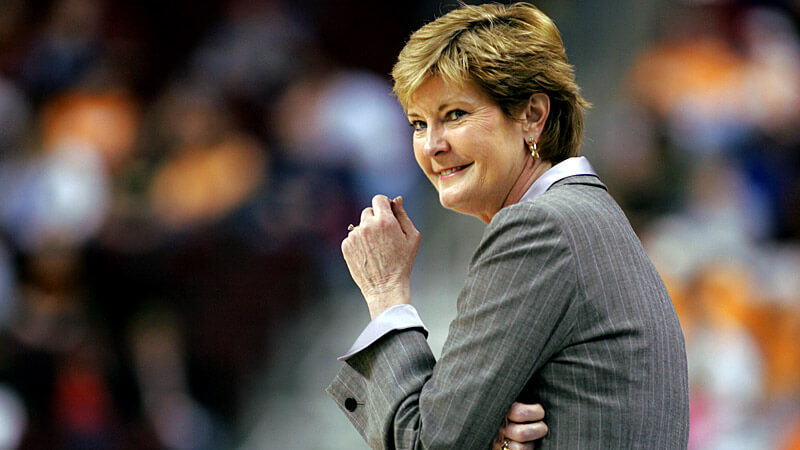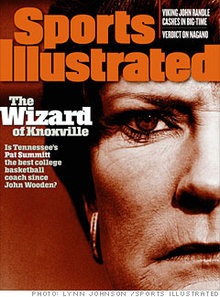
“It’s simply amazing to me the impact Pat had on so many lives, including people she didn’t know. That’s the gift God gave her, and she’ll be dearly missed.” — Tennessee coach Holly Warlick (Photo: UT Sports)
The first Women’s Final Four I ever attended was the one where Pat Summitt was reduced to the role of a most unexpected—and extremely chastened—spectator.
Well, let me take that back. Pat Summitt wasn’t going to sit still and stew while the Final Four was coming to Knoxville, and her Tennessee Lady Volunteers wouldn’t be in it.
The year was 1990, and hopes for a sellout crowd of more than 25,000 at Thompson-Boling Arena were seemingly dashed by Virginia’s upset of Tennessee in the Elite Eight.
Instead of performing a vanishing act, and after what I’m sure was no small amount of teeth-gnashing, Summitt rolled up her sleeves and got busy promoting the heck out of an event that wouldn’t involve her team.
The local Lady Vols fans who made up a healthy chunk of a then-record Final Four crowd of 20,023 watched Stanford defeat Auburn for the national championship.
Sitting on press row, I was deeply impressed. Summitt didn’t have do that, I thought to myself, to implore Tennessee fans to turn out anyway.
However, for Summitt, she DID have to do that, and not just because the premiere event in her sport was being played on her home floor. For most of her 38-year coaching career, Summitt was the driving force, the face and the identity of a sport that she transcended.
It didn’t start out that way in 1974, as a 22-year-old graduate student pressed into service when Tennessee’s head coach took a sabbatical. Title IX was only two years old, funding for her “Volettes” was scarce and she had to drive vans, launder uniforms and work with what she had, making something out of nothing.
That’s what pioneers do, even though they may not have had much of a vision at the time. But as women’s collegiate athletics grew in the 1970s and 1980s, Pat Summitt became an iconic figure who was ahead of the game in so many ways.
She took a fledgling sport and made it big. By that I don’t just mean the money, coaching salaries and television exposure of today.
Through the sheer power of her example, she generated respect not only for herself and her Lady Vols program, but for sport as a whole.
As many people have said of her titanic influence on the game of women’s college basketball, Summitt was “our John Wooden.”
By the time of her death this morning at the age of 64, nearly five years after she announced her diagnosis of early onset dementia Alzheimer’s type and four years after her retirement, Summitt’s accomplishments—8 NCAA titles, 1,098 wins, a place in the Naismith Basketball Hall of Fame for starters—have been amply relayed.
Mel Greenberg’s Summitt obituary for his old newspaper, The Philadelphia Inquirer, rounds up the reaction quite well.
 While I often had a courtside seat in Knoxville and in many other places where the Lady Vols played, and after many years of reporting on the sport, I still tried to watch with the eyes of an outsider, as someone trying to understand what could make a woman—this woman—so fiercely driven and competitive.
While I often had a courtside seat in Knoxville and in many other places where the Lady Vols played, and after many years of reporting on the sport, I still tried to watch with the eyes of an outsider, as someone trying to understand what could make a woman—this woman—so fiercely driven and competitive.
I realized years later, as her enormous legacy was extending far beyond the world of sports, that some of what drove her was what girls and young women like me, coming of age as Title IX was coming into law, also felt, but didn’t always feel like we had the cultural permission to act upon.
So when I read the opening pages of her memoir “Raise the Roof,” I snorted with delight:
“I don’t like that word, ‘girl.’ We don’t have any girls on our team. We don’t have any sweethearts, or babes, or junior misses, either. And I’m not Mary Poppins.”
She clarified by what she meant by all this:
“I’m talking about someone who was taught not to keep score. I’m talking about someone who believes the world is divided into Boy-Girl. A girl that thinks that competitiveness is the opposite of refinement. A girl isn’t bothered by the limitations society imposes on her. A girl refuses to sweat openly, and doesn’t get mad when she loses.”
Summitt gave generations of females that cultural permission, the same way Billie Jean King did for me. In my mind, they have been the most important figures in the advancement of women’s sports in the United States, and Mount Rushmore references are apt.
What both women had in common, I think, was how they blended differing styles of activism with their athletic careers in ways that men could appreciate.
King was more overtly political, marching at feminist rallies in the 1970s and risking all with her efforts for equal prize money and to establish a women’s tennis tour.
The daughter of a stern farmer, Summitt was more stealth but no less determined. She testified on behalf of a lawsuit to rid Tennessee high school ranks of six-on-six basketball that many girls (myself included) had grown up playing.
Jack Fertig, a men’s assistant basketball coach at Tennessee in the early 1980s once told me that Summitt would state how many pairs of sneakers she would need for the coming season. If the men had more, she didn’t care, as long as her players had what they required. If her team didn’t get what it needed and the men had more, then there was a problem.
While some women’s sports activists, as Fertig put it, “have their eye on the wrong scoreboard,” Summitt picked her gender equity battles wisely. She went about pushing her players and herself beyond what was expected of them, simply because they were females.
At the same time, she was also starting to develop a vision for the college game beyond its humble beginnings. While acknowledging the importance of the AIAW, the all-female organization that governed women’s college sports for most of the 1970s, Summitt said that participating in the first NCAA women’s tournament in 1982 was “clear cut.”
That wasn’t always a popular stance to take. Although the AIAW was embroiled in internal divisions over this issue, publicly much was made of an NCAA “takeover” of women’s sports. The truth was that many women, including Pat Summitt and key AIAW leaders, thought the NCAA was the better option for the future.
Even when promoting the sport might not have been the best option for her program, Summitt did it anyway, as longtime ESPN women’s programming executive Carol Stiff pointed out in her tribute.
That included the birth of the UConn-Tennessee rivalry in 1995 that changed women’s college basketball forever. She took the Lady Vols to the desert to play Arizona State in a football stadium, and helped christen Louisville’s new arena, among other promotional deeds that are too numerous to fully recount here.
In the late 1990s, as Tennessee was closing in on three consecutive NCAA titles, Gary Smith’s profile in Sports Illustrated helped many of those outside the sport—as well as the inside—truly appreciate what made her tick.
Summitt wasn’t enamored with the cover photo, and those around her knew that her famous glare and stern disciplinarian ways didn’t completely define her.
Holly Warlick, who played for and coached with Summitt and succeeded her in 2012, said this morning on a conference call that her mentor played such a vital role as a female coach in combining toughness and “showing love. That’s hard to do, being demanding and then putting your arm around them and telling them you love them.”
In “Raise the Roof,” as she reflected on the essence of her role as a coach, Summitt explained that hard and relentless work is the only way to become successful, and one must revel in doing the work:
“Let’s face it. Women aren’t becoming firefighters, pro athletes and space shuttle astronauts these days just because political activists waved signs. Somewhere along the line, a woman had to prove she could pull a 250-pound man from a burning building.”
The last time I chatted with Summitt, after a Lady Vols game at the 2010 SEC Tournament, I could not have imagined the rapid demise that was about to come.
She looked fantastic, in her tailored suit and professional coiffure, her steely gaze making contact with my eyes, and her firm handshake gripping my right hand with authority.
It was a brief conversation, an exchange of pleasantries, and I thought at the time this woman may coach forever. She may be gone, but Summitt moved mountains, and inspired many others to follow her example.
Her life’s work, of “redefining what young women are capable of and how they compete,” will endure forever.
Wendy Parker is a sportswriter and web editor who has covered women's basketball since the early 1990s. She is a correspondent for Basketball Times and formerly covered women's and college sports, soccer and the Olympics at The Atlanta Journal-Constitution. She is the author of "Beyond Title IX: The Cultural Laments of Women's Sports," available on Amazon, and the creator of Sports Biblio, a blog about sports books and history.




